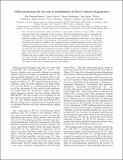Por favor, use este identificador para citar o enlazar a este item:
http://hdl.handle.net/10261/270683COMPARTIR / EXPORTAR:
 SHARE SHARE
 CORE
BASE CORE
BASE
|
|
| Visualizar otros formatos: MARC | Dublin Core | RDF | ORE | MODS | METS | DIDL | DATACITE | |

| Título: | Global predictions for the risk of establishment of Pierce’s disease of grapevines |
Autor: | Giménez-Romero, Alex CSIC ORCID; Galván Fraile, Javier; Montesinos, Marina; Bauzà, Joan; Godefroid, Martín CSIC ORCID; Fereres, Alberto CSIC ORCID; Ramasco, José J. CSIC ORCID ; Matías, Manuel A. CSIC ORCID ; Moralejo, Eduardo CSIC ORCID | Fecha de publicación: | 20-may-2022 | Editor: | BioRxiv | Citación: | Giménez-Romero, Alex; Galván Fraile, Javier; Montesinos, Marina; Bauzà, Joan; Godefroid, Martin; Fereres, Alberto; Ramasco, José J.; Matías, Manuel A.; Moralejo, Eduardo; 2022; Global predictions for the risk of establishment of Pierce’s disease of grapevines [preprint]; BioRxiv; https://doi.org/10.1101/2022.05.20.492796 | Resumen: | The vector-borne bacterium Xylella fastidiosa is responsible for Pierce's disease (PD), a lethal grapevine illness that originated in the Americas. The international plant trade is expanding the geographic range of this pathogen, posing a new threat to viticulture worldwide. To assess the potential incidence of PD, we have built a dynamic epidemiological model based on the response of 36-grapevine varieties to the pathogen in inoculation assays and on the vectors' distribution when this information is available. Key temperature-driven epidemiological processes, such as PD symptom development and recovery, are mechanistically modelled. Integrating into the model high-resolution spatiotemporal climatic data from 1981 onward and different infectivity (R0) scenarios, we show how the main wine-producing areas thrive mostly in non-risk, transient, or epidemic-risk zones with potentially low growth rates in PD incidence. Epidemic-risk zones with moderate to high growth rates are currently marginal outside the United States. However, a global expansion of epidemic-risk zones coupled with small increments in the disease growth rate is projected for 2050. Our study globally downscales the risk of PD establishment while highlighting the importance of considering climate variability, vector distribution and an invasive criterion in obtaining accurate risk maps to guide policy decision-making in plant health. | Versión del editor: | https://doi.org/10.1101/2022.05.20.492796 | URI: | http://hdl.handle.net/10261/270683 | DOI: | 10.1101/2022.05.20.492796 | Referencias: | Giménez-Romero, Alex; Galván Fraile, Javier; Montesinos, Marina; Bauzà, Joan; Godefroid, Martin; Fereres, Alberto; Ramasco, José J.; Matías, Manuel A.; Moralejo, Eduardo. Global predictions for the risk of establishment of Pierce's disease of grapevines. Communications Biology 5: 1389 (2022). https://doi.org/10.1007/s00406-021-01256-w . http://hdl.handle.net/10261/305247 |
| Aparece en las colecciones: | (IFISC) Artículos |
Ficheros en este ítem:
| Fichero | Descripción | Tamaño | Formato | |
|---|---|---|---|---|
| Pierces_disease_grapevines.pdf | 20,01 MB | Adobe PDF |  Visualizar/Abrir |
CORE Recommender
Page view(s)
72
checked on 27-abr-2024
Download(s)
77
checked on 27-abr-2024
Google ScholarTM
Check
Altmetric
Altmetric
Este item está licenciado bajo una Licencia Creative Commons

